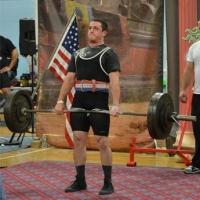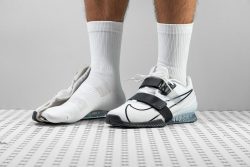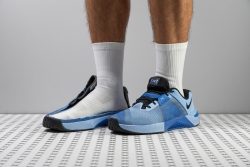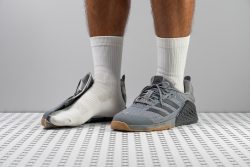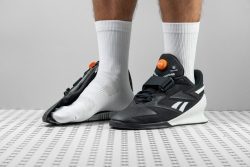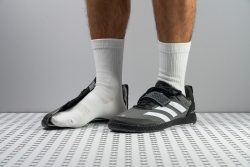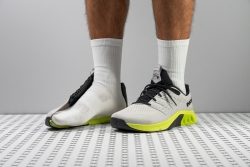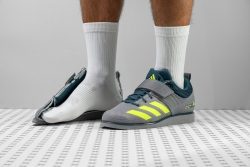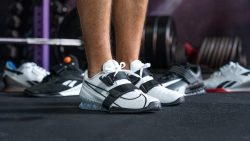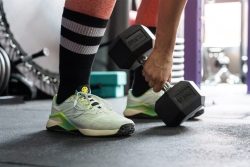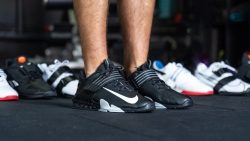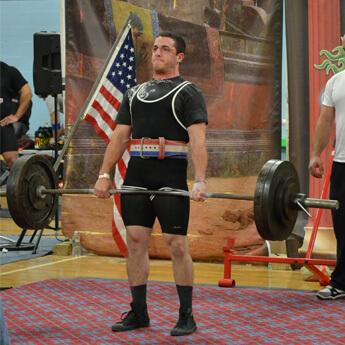7 Best Weightlifting Shoes For Women in 2025
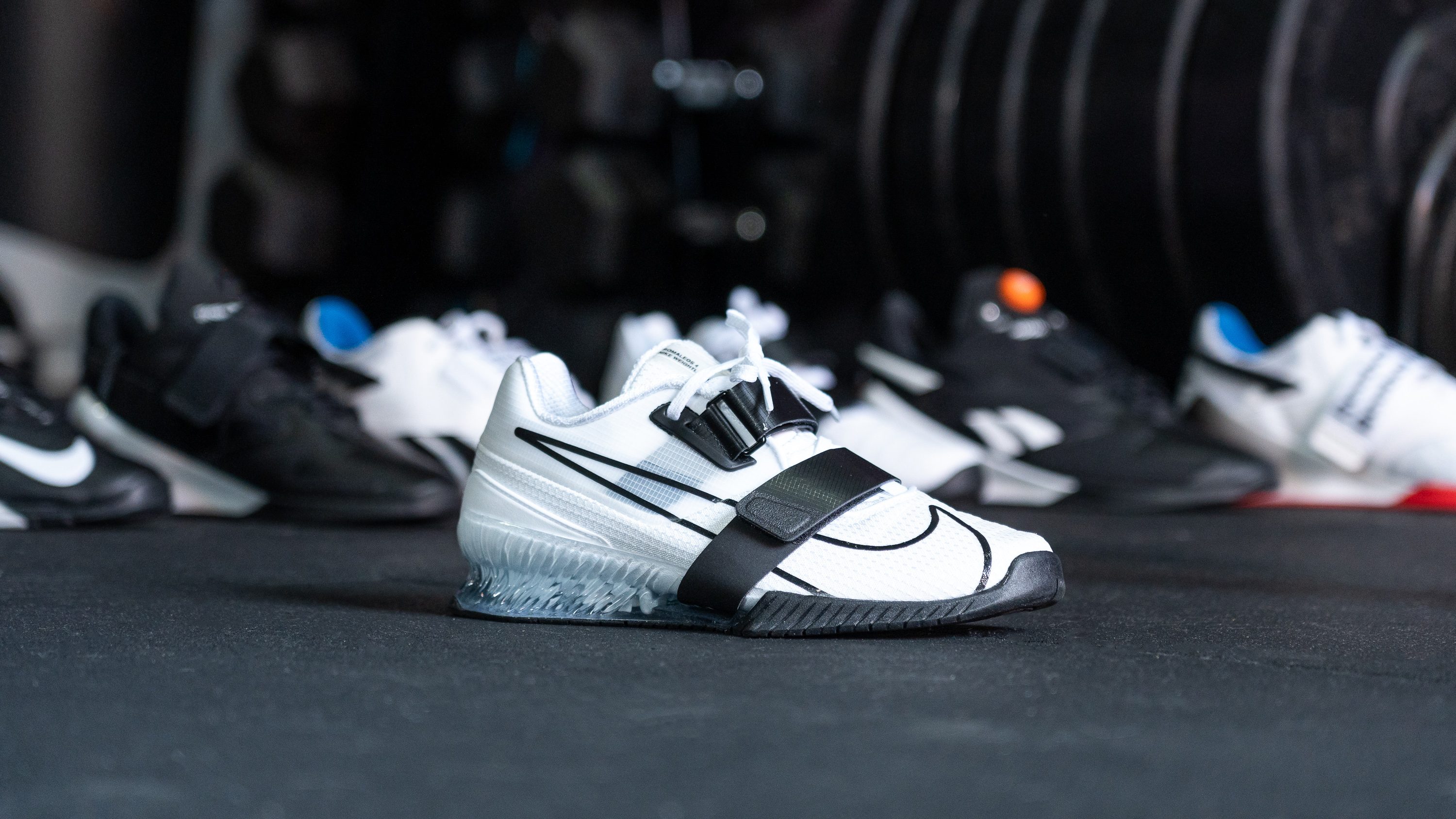
We buy shoes ourselves. We earn commissions when you buy through us, at no extra cost. Why trust us
Weightlifting can be part of a workout program like CrossFit or a discipline on its own.
It has unique demands such as maintaining an upright posture and a deeply and securely rooted stance. A good weightlifting shoe for the ladies is going to be helpful in meeting these demands.
But depending on your fitness goals, you may not always need a stiff high-heeled lifter. In fact, a regular stable cross-trainer or a flat shoe can be preferable. This guide will help you find the right option for you.
How we test weightlifting shoes for women
In our lab, each shoe goes through a meticulous testing process before we can recommend it as a weightlifting shoe for the ladies. It is a multi-step process which involves a great amount of time and effort:
- We buy all lifting shoes with our own money to avoid bias and brand loyalty.
- We perform squats, cleans, jerks, among other kinds of lifts to get a good feel of each shoe in person.
- We use calipers, durometers, and specialized shoe-testing equipment to measure over 30 different shoe parameters. That even involves cutting shoes in half to measure their stack, drop, platform density, and more. All the collected data allows us to provide detailed, objective, and comprehensive reviews of each weightlifting shoe.
In the end, we shortlist the cream of the crop among lifting shoes for women.
Best women's weightlifting shoes overall
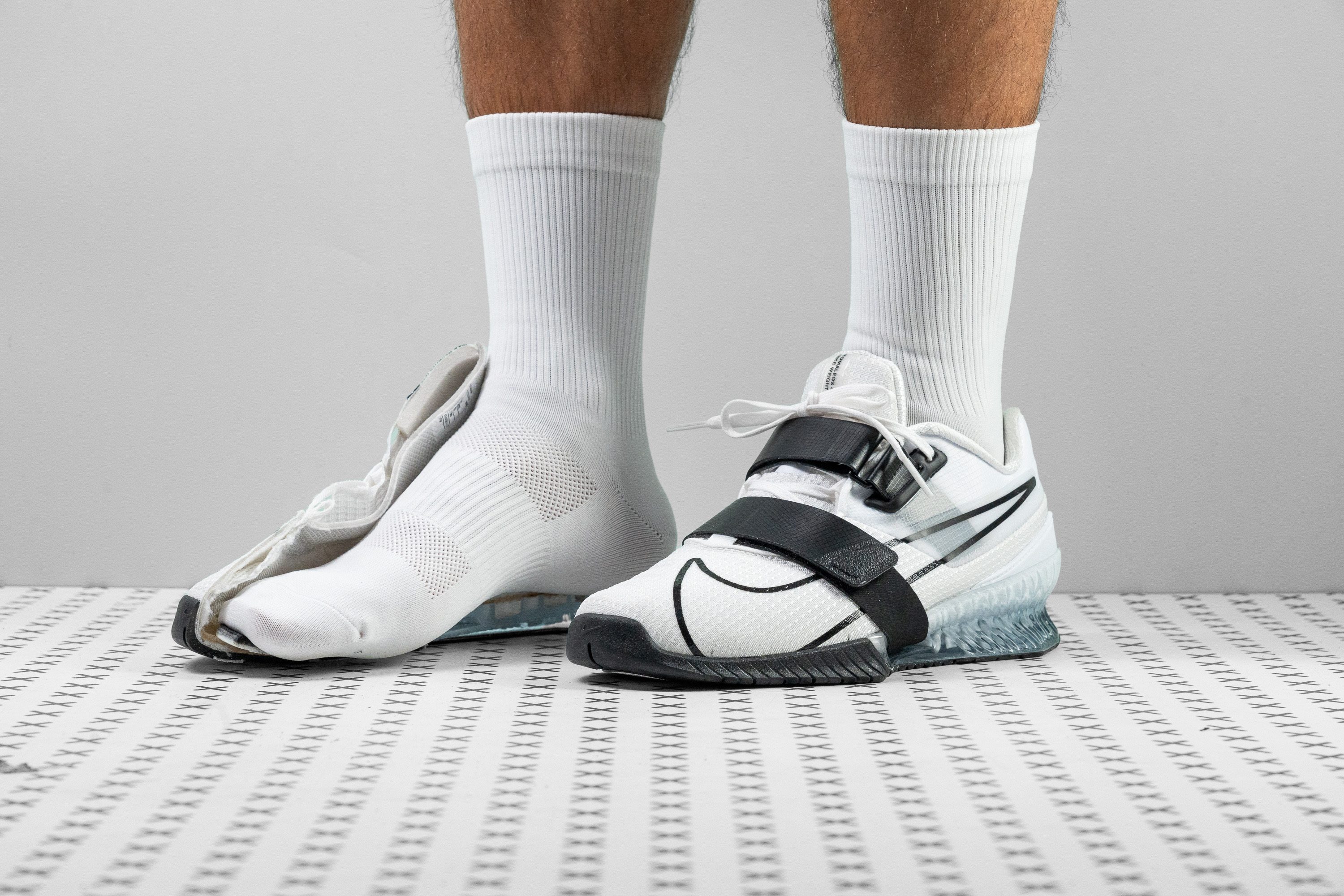





























What makes it the best?
The Nike Romaleos 4 gave us no-fail and locked-in support during testing. Our lab results show it truly deserves to be the top weightlifting shoe for women because of its unrivaled firmness, highly secure foothold, and superior rigidity.
The platform’s unmatched stability comes from its very firm base. At 97.0 HA, our durometer shows it’s the firmest lifter we’ve seen by far. With a reading 40.2% above average, it had no compression whatsoever and can handle elite-level female weightlifters.
Our feet felt confident as the TPU walls, stiff heel counter, and two Velcro straps all formed a sturdy network that kept us centered. In our manual assessment, we pinched the heel counter and awarded it the highest 5/5 stiffness score.
In terms of twisting, the shoe also had no give, so we gave it the highest 5/5 torsional rigidity rating. At this level, it takes a lot of effort to lose balance in the base, especially since it runs wide at 111.5/91.3 mm.
Unfortunately, the shoe will feel stuffy during heated sessions or warmer conditions. Women who want to avoid the sauna-like sensation should explore more breathable options.
Pros
- Phenomenal stability
- Sturdy platform and sole
- Better lockdown with two straps
- Comfortable for a lifting shoe
- True to size
- Efficient traction
- Appealing looks
Cons
- Upper lacks durability
- Not for narrow ankles
- Not breathable
Best women's cross-training shoes for weightlifting
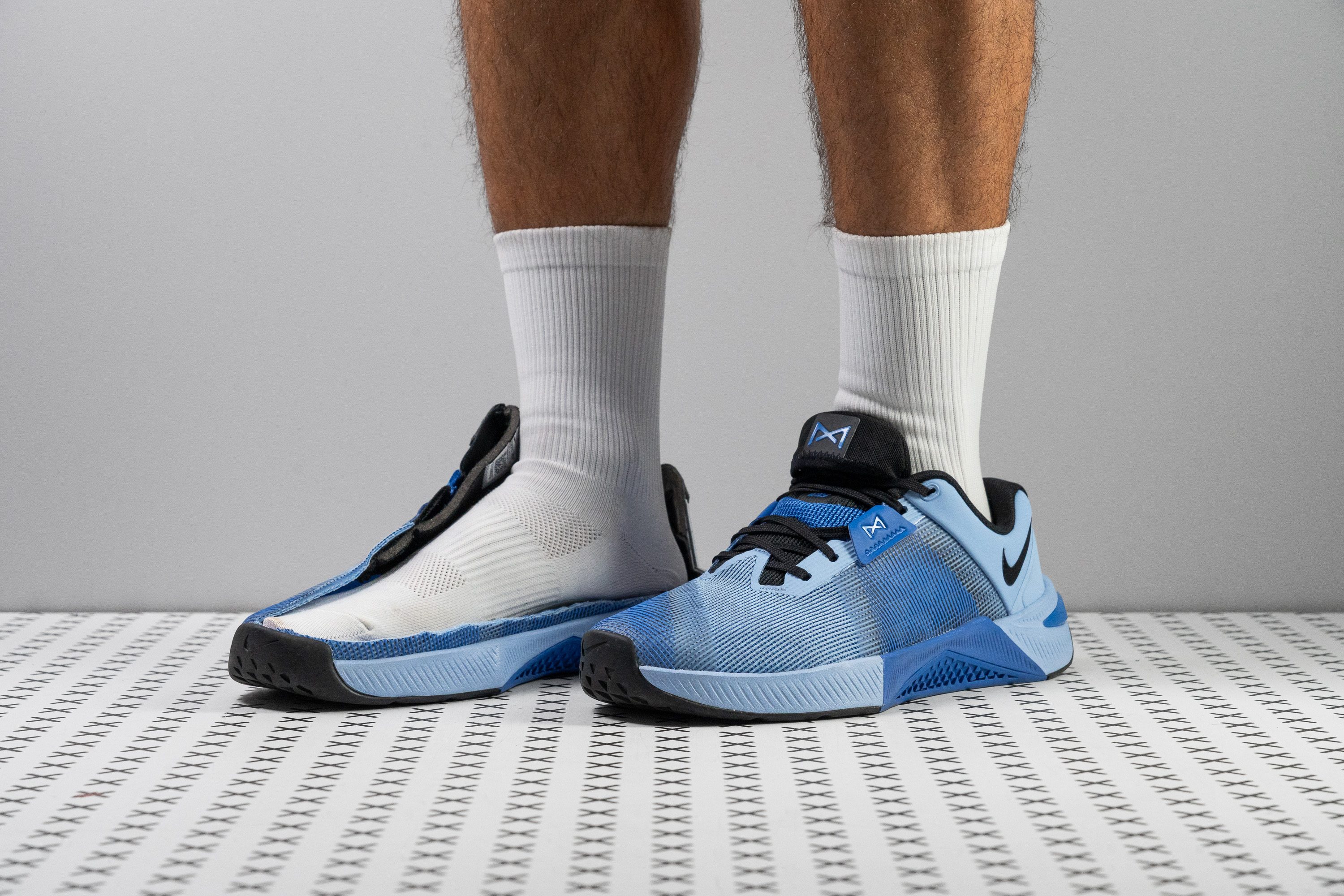














































What makes it the best?
We believe women seeking a weightlifting shoe that can be a cross-trainer have the Nike Metcon 10 as a top choice. Thanks to its firm base and slight give, we validated through lab tests that it ensures a confident footing without restricting motion. The wide midsole adds stability, complemented by reliable traction underneath.
Metcon 10 features a sturdy base, consistent with weightlifting shoes’ DNA. Our caliper shows it’s a grounded 22.8/16.2 mm, while the heel features a sturdy Hyperlift plastic for further reinforcements, giving women more confidence to test heavier loads.
Despite its unshakeable foundation, it surprisingly offers lots of room for foot-bending workouts such as planks and burpees. Our bend test shows it’s even 13.2% more malleable than average, making it versatile enough for other gym workouts as well.
The platform runs wider than average, measuring 115.2/90.8 mm, and ensures a well-planted feeling. Underneath is a highly grippy outsole that gave us precision while performing dynamic footwork. We tested the 004 Stick Rubber in the heel and forefoot, and it returned an impressive 0.38 friction coefficient in our traction test, proving its reliability.
However, we find that it lacks shock absorption for longer sessions of walking and rope jumps. Women seeking more joint protection should go for a more cushioned trainer.
Pros
- More versatile Metcon overall
- One of the lightest Metcons ever!
- ReactX adds shock absorption and energy return
- Increased forefoot flexibility
- Still amazingly stable for weightlifting
- Fantastic upper durability (even for rope climbs)
- Great grip on gym floors
- Highly secure foot lockdown
- Accommodating fit and toebox
- Handy Lace Tuck
Cons
- Outsole could be more durable
- Upper lacks breathability
Best women's weightlifting shoes for beginners
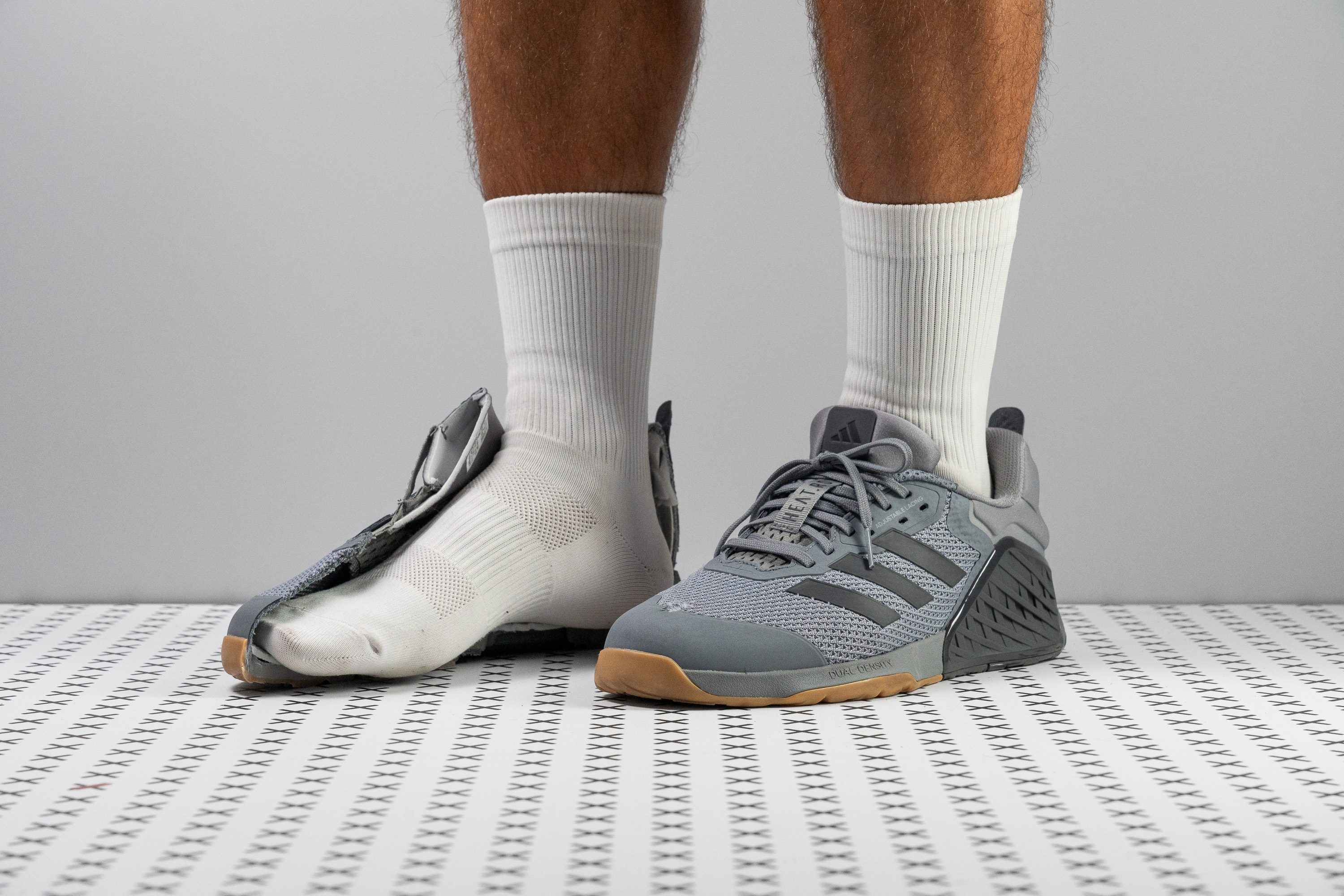





















































What makes it the best?
During our sessions with the Adidas Dropset 3, the reinforced platform offered unmatched stability and peace of mind. We hardly dropped any sets because of the firm heel and secure foothold, aligning with what we saw in the lab. It offers maximum breathability through the HEAT.RDY technology and delivers a very beginner-friendly experience for women who are new to lifting.
The midsole was a pleasure to test because it offers a good mix of cushioning, ground feel, and sure-footedness. The forefoot is only 14.8 mm thin, yet is a soft 21.5 HA, delivering comfort and surface feedback. Meanwhile, our durometer shows the heel is a rock-solid 41.0 HA, 47.5% firmer than average. This gives us no reason to doubt its support under heavy loads, perfect for women who want to test their PR weights.
We had no feeling of losing our balance because our ankles were held firmly in place. Thankfully, the GeoFit Sensepods add padding around this area for extra comfort.
We were excited to test the shoe’s breathability because of the HEAT.RDY technology. This includes a large aperture in the middle of the sole to expel our body heat. In addition, the fabric easily allows airflow, as seen in its perfect 5/5 score in our smoke test.
Unfortunately, all the reinforcements led to a heavy 12.1 oz (343g). Women who prefer lightweight shoes should check alternatives.
Pros
- Exceptional stability for lifting and lateral movements
- Very wide and grounded platform
- Extra durable and grippy outsole
- Very secure foothold
- Flexible enough for plyometrics
- Fantastic breathability
- Accommodating toebox
Cons
- Not great for running and walking (clunky heel)
- Can't be worn outside because of sole apertures
Best weightlifting shoes for advanced athletes
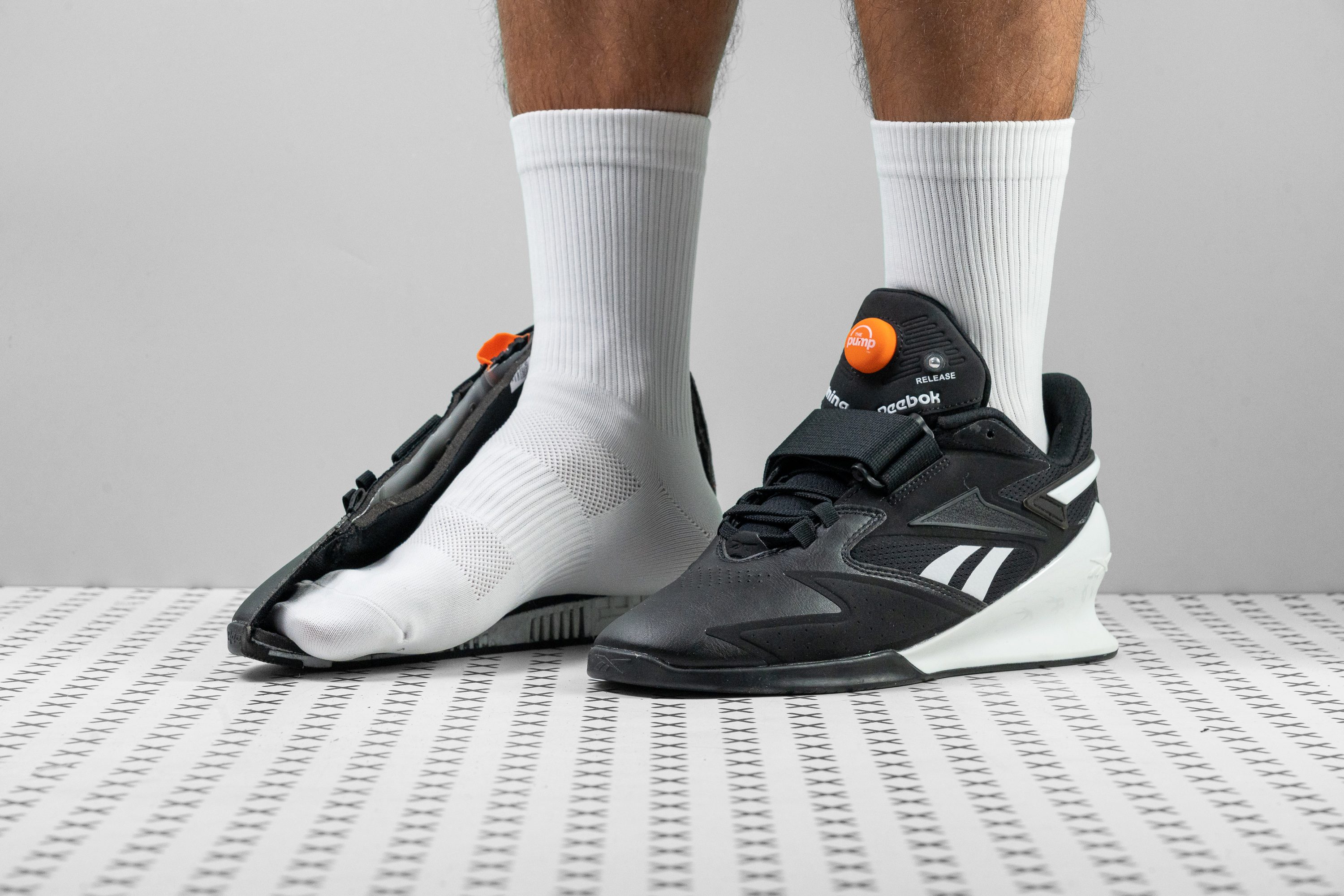




































What makes it the best?
Almost every feature of the Reebok Legacy Lifter III we tested in the lab proves it’s undoubtedly made for lifters. The shoe did not budge whatsoever as we lifted record-breaking weights with its firm base, stiff construction, and heavy-like-a-rock build. Among women’s weightlifting shoes, we recommend this pair for advanced athletes.
Legacy Lifter III has an unshakeable foundation. Our durometer shows the foam has a high 95.1 HA reading, which makes it 37.4% firmer than average. On foot, we felt like it wouldn’t collapse even if we carried 300 pounds. The platform features a significant 20.5 mm heel elevation, which helps us to lift in proper form.
The shoe’s stable underfoot sensation also stems from its rigid construction. It doesn’t budge to lateral movements, and we never felt like toppling over. Our manual test confirms it offers the maximum 5/5 torsional rigidity level.
Legacy Lifter III has a heavy weight that worked to our advantage because it anchored us to the ground. Our scales show it’s 22.1 oz (627g), a whopping 26.2% above average!
Unfortunately, it’s heavy on the wallet, too. Women who don’t want to spend $220 on a lifting shoe should try alternatives.
Pros
- Mind-blowing stability
- Incompressible platform
- High heel helps with posture for squats
- Highly supportive upper
- Top-notch durability
- The Pump feature is fun and improves the fit
Cons
- Unreasonable price hike
- Short Velcro attachment
Best women's weightlifting shoes for deadlifts















































What makes it the best?
Our strength training felt more efficient while using the Adidas The Total. Based on our lab tests, its firm base, zero drop, solid foothold, and surefooted traction make it the most ideal for deadlifts among women’s weightlifting shoes.
The Total features a low profile, confirmed by our caliper with a 12.5 mm measurement on both the heel and forefoot. This thin cushion, paired with its true zero heel drop, enhances surface feedback and control. We pushed our durometer against the foam and found it to be a firm 40.0 HA, preventing any wobbly or off-balance moments.
The lockdown feels very secure, with a foot strap keeping our feet planted. The stiff heel counter (4/5) held our ankles firmly without causing discomfort, enhancing women’s confidence to keep adding weights to the barbell.
The grippy outsole enhanced our form and precision as well, regardless of the surface. Whether on slippery gym floors or rubber mats, we had no instances of slipping and losing balance.
Unfortunately, it lacks breathability (2/5) for hot weather and drenched our socks in sweat. Women who want to avoid this experience should look for another pair.
Pros
- Ideal for deadlifting
- Great traction
- A lot of ground feel
- Plenty of toebox space
- Lightweight and comfortable
- Fairly priced
- Streamlined look
Cons
- Not so much breathability
- Not for heavy squats
Best hybrid weightlifting shoes for women
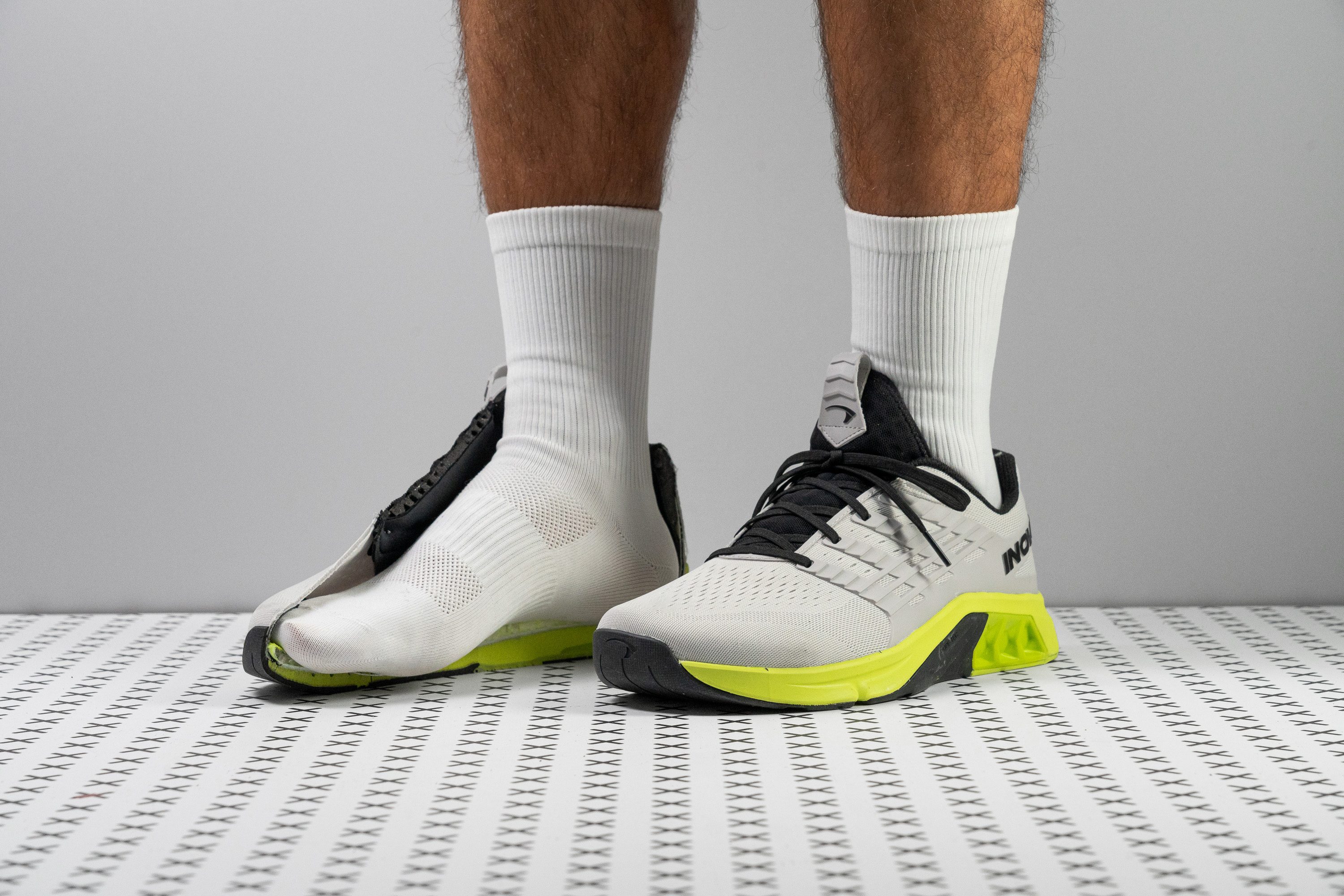























































What makes it the best?
The Inov8 F-Lite Max ingeniously mixes a rock-solid platform with freedom up front, making it our best hybrid shoe in the women’s weightlifting category. We dug deeper in the lab and found its exceptionally sturdy heel paired with a responsive and flexible forefoot. Air flows nonstop, wrapping up the overall pleasant experience.
This shoe feels like a cross-trainer through its bouncy forefoot cushion, while its weightlifting persona comes alive through its rear. The heel has a very firm 88.0 HA TPU stabilizer. Even as we kept adding weights, it did not waver and remained balanced, so women attempting to break PRs will be supported by this platform.
What makes F-Lite Max versatile is its adaptive forefoot. In our flex test, it emerged 5.5% more malleable than average, allowing us to perform lunges, burpees, and planks effectively.
The upper feels airy, and we saw how delicate the fabric is under our light test. It offers maximum ventilation, demonstrated by how smoke quickly escaped the shoe in our lab test, and earned a 5/5 breathability score.
Because the toebox isn’t dense, our Dremel wrecked the material and earned the lowest 1/5 toebox durability score. Women who want a more reinforced upper should try alternatives.
Pros
- Fantastic stability for lifting and Crossfit
- Great for heavier lifting (stiff TPU heel)
- Awesome for wide feet
- Good forefoot flexiblity
- Highly breathable toebox
- Solid outsole durability
- Protection for rope climbs
- The stickiest outsole rubber
Cons
- Heavier than average
- Clunky and firm for HIIT/cardio
- Frail upper fabric
Women's weightlifting shoes with the best value
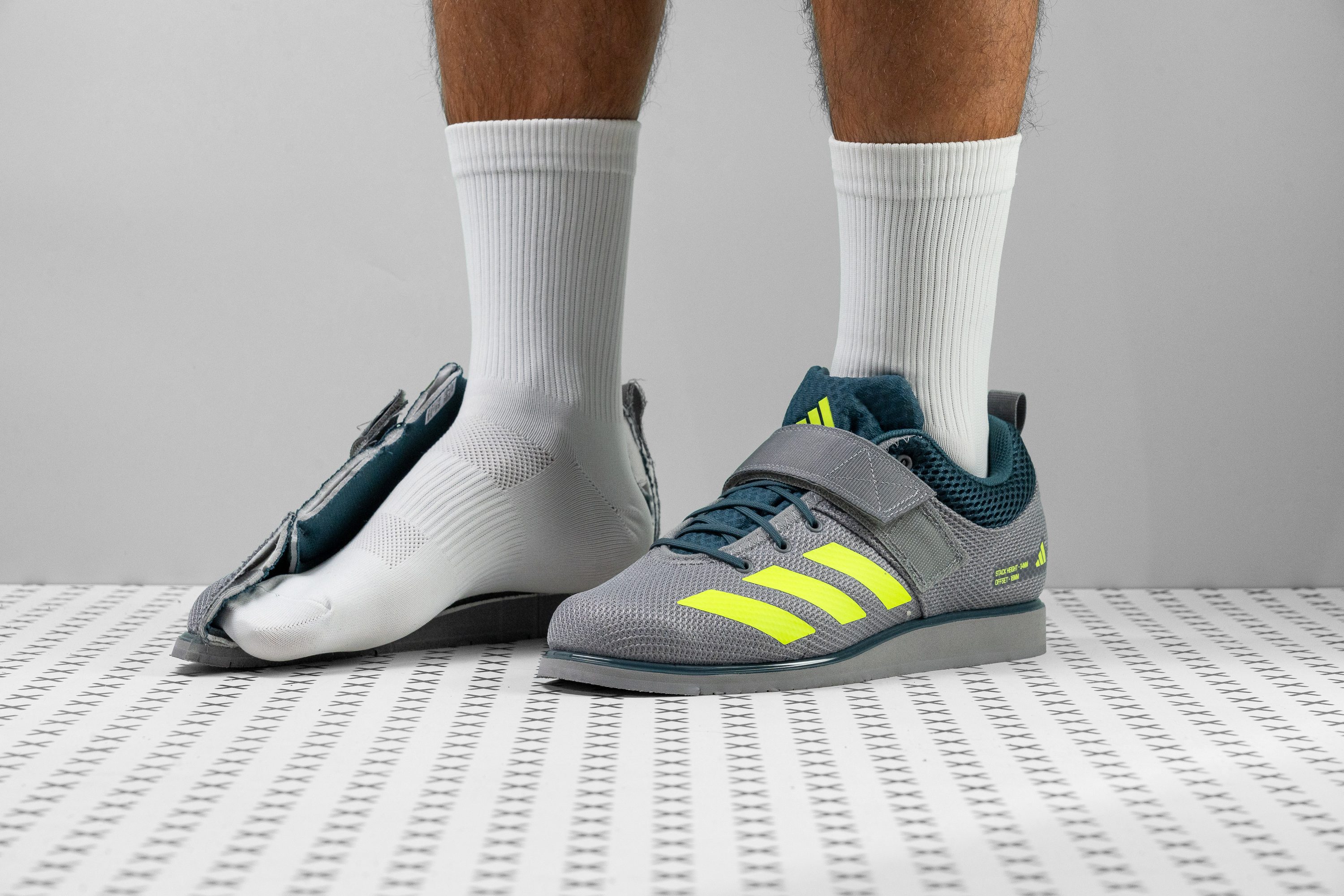













































What makes it the best?
Among the women’s weightlifting shoes we brought to the gym and in the lab, the Adidas Powerlift 5 stood out as the best value. It packs a lot of support and versatility into its light build and non-intimidating $120 price tag.
The Powerlift 5 feels stable without being too hardcore, as seen in its lab results. It features a more subtle 15.2 mm drop, which still helps us perform squats and lifts properly. Using our durometer, we measured the cushion at 51.0 HA, 26.3% softer than average. At this level, it won’t easily compress for beginner to intermediate-level weights.
The Powerlift 5 features a light and fluid figure that makes it suitable for activities beyond lifting. At 15.0 oz (425g), it’s 14.5% lighter than average. In terms of adaptability, we found it 15.8% more bendable than average, perfect for women seeking a more comfortable shoe.
Still, it doesn’t waver under a loaded barbell. The midsole had no give to twisting, and the heel counter was hard to pinch, so we rated both the maximum 5/5 stiffness rating, securing our stance and foothold firmly.
Ladies who want to lift over 350 pounds should find a more supportive shoe. This pair is more suited for beginners and casual lifters.
Pros
- Stable base for moderate lifting
- Good for accessory exercises
- Solid bite on gym floors
- Secure foothold
- Supportive Velcro strap
- Reasonably priced
- Contains sustainable materials
Cons
- Lacks breathability
- Upper is not very durable
- Tongue shifts
Reasons to buy weightlifting shoes
A dedicated lifting shoe is a tool that helps to boost your performance in the following scenarios:
You focus on Olympic weightlifting
Stiff and high-heeled lifting shoes are specifically designed for the following exercises:
- Squats
- Clean and jerks
- Snatches
- Push presses
They can also be worn for lower body exercises such as the leg press and the hack squat.
It’s easy to confuse weightlifting as a sport regimen with weight [blank] lifting as a broader term used for strength training with added weight (could be dumbbells, kettlebells, etc.). If you need shoes for the latter, regular cross-trainers will do the job perfectly.
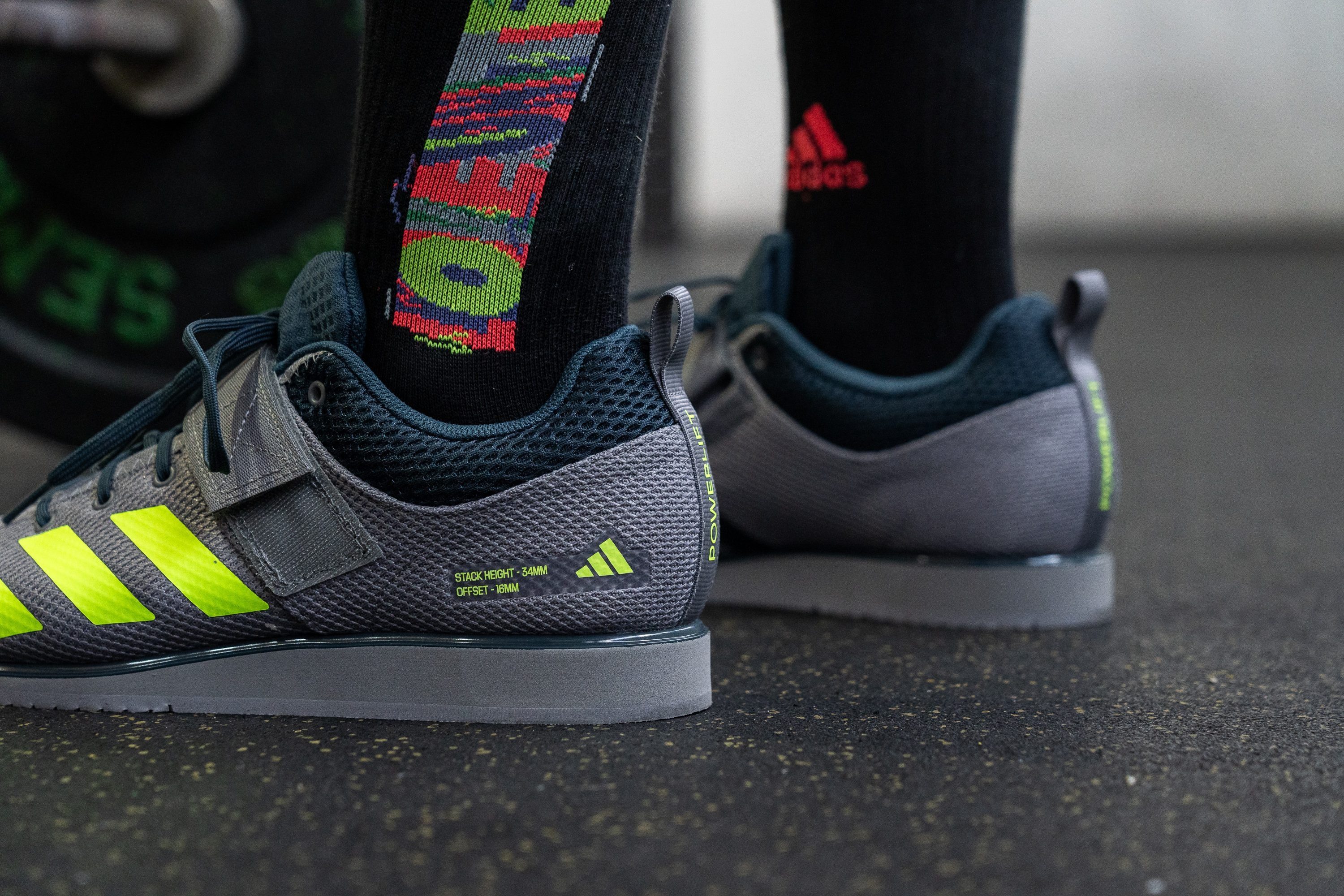
You want all the stability you can get
Rigid weightlifting shoes provide that all-important secure base to push from. Even though it might seem easier to do your heavy lifts in your everyday trainers or running shoes, you won’t be able to perform as well, or as safely, if you do!
The solid heel of a woman’s weightlifting shoe, combined with a secure lockdown system, firm midsole and enhanced sole grip prevent the tiny foot movement that could jeopardize your safety and dissipate your power.
You want proper squat form and better quad activation
Ladies who squat in flat shoes (low heel-to-toe drop) have a tendency to round their backs as they push out of the bottom position of the exercise. That’s not good as it puts a lot of stress on the spinal discs, which is compounded by the compressive pressure of the weight on the bar.
Squatting with an elevated heel helps to overcome the rounded back problem. When your heel is higher than your toe, you will automatically maintain a more upright torso position as you go in and out of a squat. This increased biomechanical positioning allows you to bring your knees forward beyond your toes, which naturally keeps your torso more upright.
What’s more, when you squat with a raised heel, your knees are able to track over your toes which allows for greater knee flexion and reduced hip flexion. The result is greater involvement of the quads instead of glutes or hamstrings.
If you are geeky about the nuances of how different types of footwear affect your weightlifting form, see our science-backed guide to lifting shoes.

You have poor ankle mobility
The rigid heel and higher heel height of women’s weightlifting shoes reduce ankle dorsiflexion. This is the reflexive drawing of the toes back to the shin that can increase your chance of suffering an ankle injury.
Reasons NOT to buy weightlifting shoes
Designed with very specific movements in mind, lifting shoes are a pretty niche type of footwear. That’s why it may not be worth investing in one if you recognize yourself in one of the following situations:
You need a versatile trainer
If weightlifting is only part of your training regimen and you also include a lot of cardio and plyometric exercises, then you need a pair of versatile cross-trainers. Lifting shoes are way too stiff, heavy, and clunky for movements like jumps, lunges, and planks.
Luckily, there are many do-it-all trainers that allow you to perform a wide variety of gym exercises without compromising stability for strength training. Some of the most popular shoe series include Nike Metcons and Reebok Nanos.
There are also a few hybrid options that resemble lifting shoes with their stiff heels and more pronounced TPU sidewalls.

You want to improve ankle mobility
If you are not aiming to hit a PR weight every other workout and your goal is instead to work on natural ankle mobility and squat depth, then you don’t need a dedicated lifting shoe either.
You can use your regular pair of workout shoes or even consider using minimalist (aka barefoot) trainers to work on foot strength. But please note that if you haven’t trained in this type of footwear before, you must go slow and allow for an adaptation period because your body needs time to adapt to completely different (shoeless) biomechanics.
You focus on deadlifting
There is a good reason why high-heeled lifting shoes are sometimes called “squat shoes.” That’s because their construction is optimized for squatting with weight and not so much for leaning forward to grab the barbell.
Performing deadlifts in high-drop shoes increases your lifting range of motion and compromises hip positioning during the movement. Typical deadlifting shoes have a flat and grounded base which helps to center weight over the midfoot supporting good posture.
There isn’t a ton of dedicated deadlift shoes on the market (Adidas The Total is a rare example) but you can also choose from minimalist shoes, low-drop trainers, or firm flat-soled kicks like Converse Chucks.
What makes a good women's weightlifting shoe
To explain the importance of having a solid foot position when weightlifting, I like to use the illustration of firing a cannon.
Imagine the effect of firing a cannon from a canoe. Most of the explosive force of the cannon shot will be lost due to the instability of the firing platform - and you’ll probably end up being catapulted into the water!
A similar thing happens if you don’t have a secure foot position when weightlifting. You’ll end up losing a large proportion of your lifting force through shoe cushioning, lateral foot movement, and other unwanted power leaks.
Here are the must-have components of a reliable weightlifting shoe for women:
- High drop
- Stiff heel
- Wide base
- Secure lockdown
High drop
A high heel-to-toe offset implies that your heel is elevated above the toes anywhere from 15 mm (0.6 inch) to 22 mm (1 inch). This setup helps you squat deeper and in a more upright position.
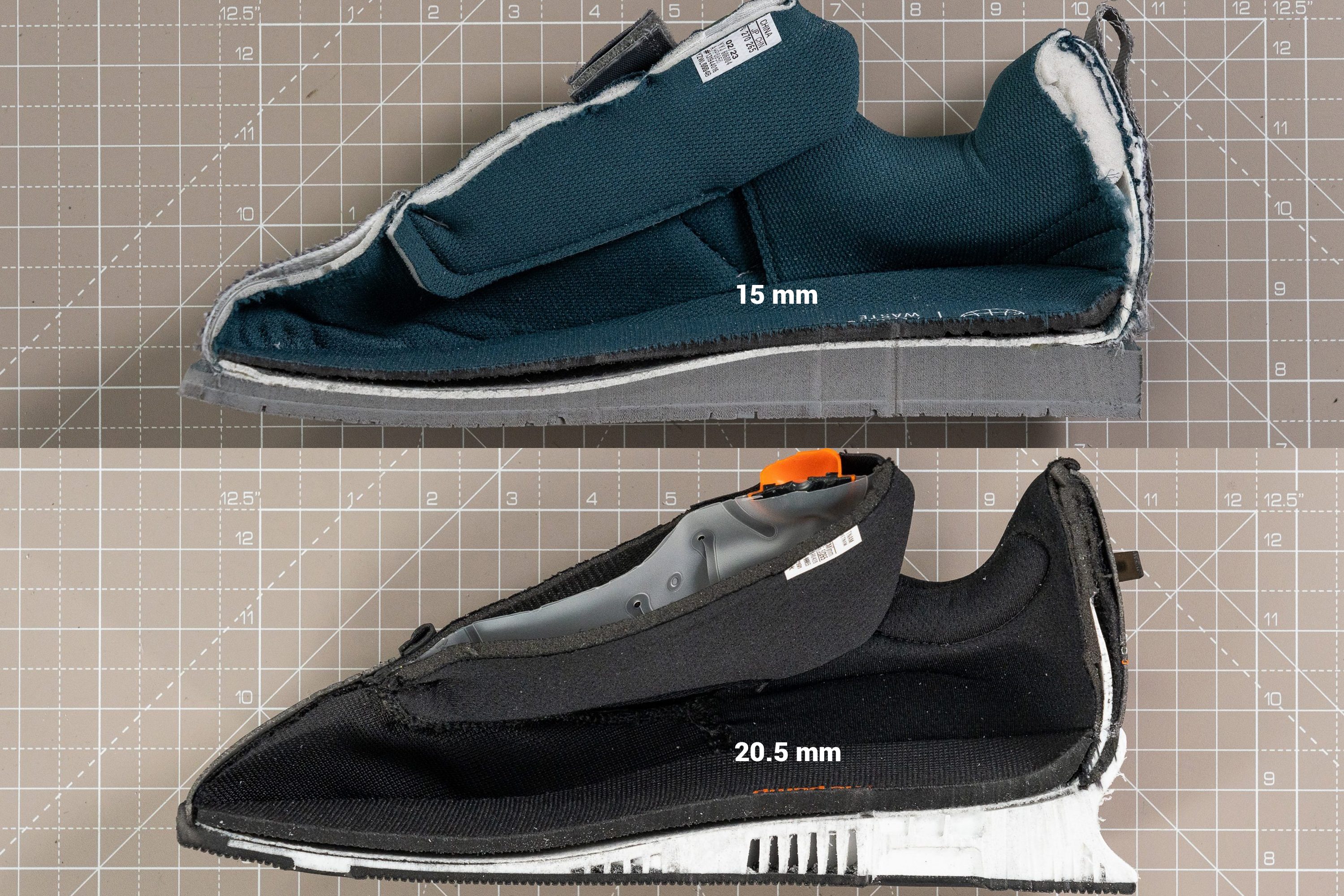
The ideal elevation for you will depend on your squatting style and the length of your femur (thigh bone). Here are some general guidelines:
|
Choose a lower heel if: |
Choose a higher heel if: |
|
|
TIP: At the end of the day, the best heel elevation for you is the one that feels most natural. If possible, put the shoe on and move about in it before committing to the purchase. If you’re buying online, you can still go into a retailer and try on a pair of the shoes you’ve got your sights on. Perform a few bodyweight squats to assess the movement pattern and comfort level.
Stiff heel
Made of incompressible TPU or extremely dense EVA foam, the heels of lifting shoes remain sturdy even under the heaviest loads.

Wide base
The midsoles of lifting shoes are broad both in the heel and in the forefoot creating a stable base to rely on.
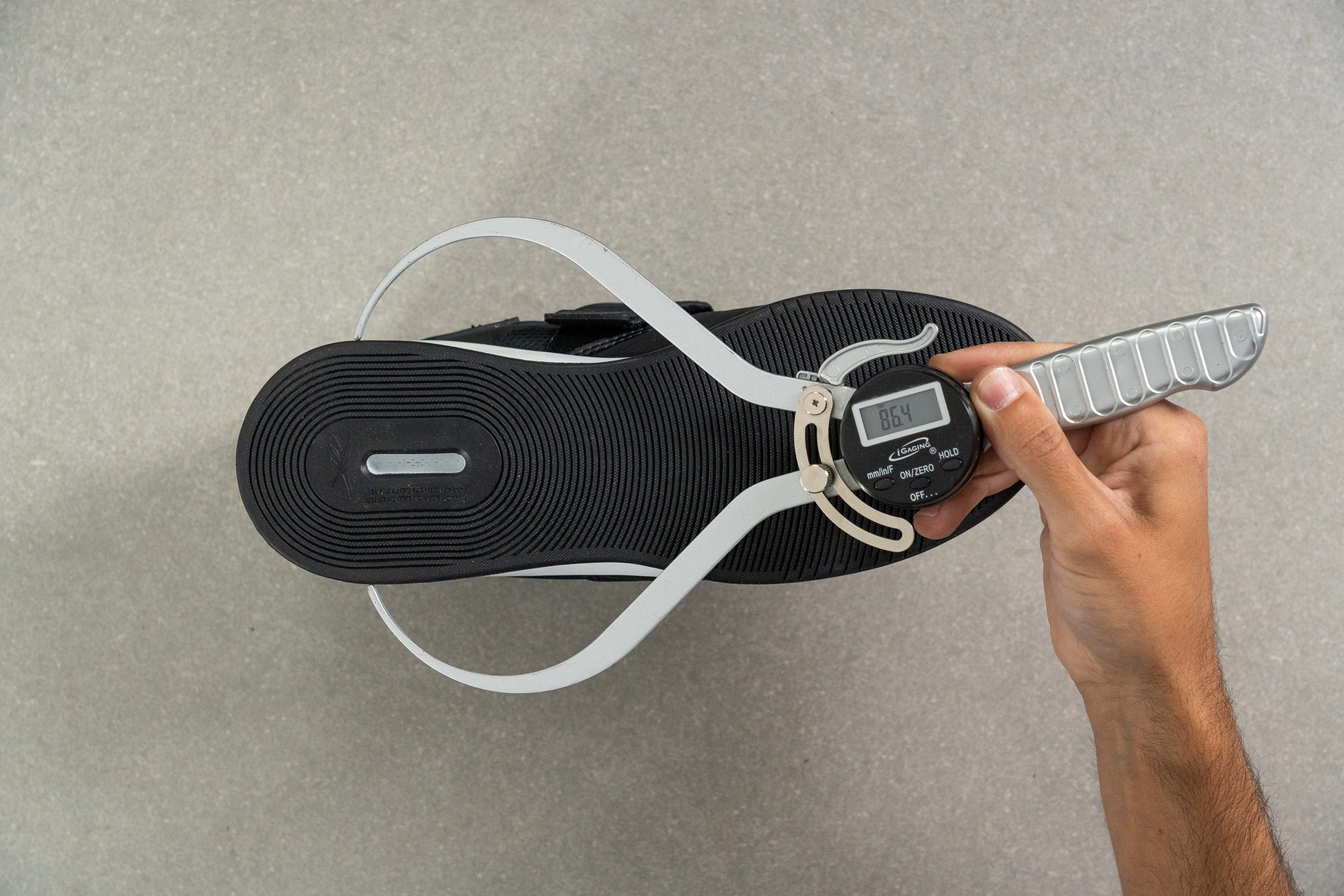
Secure lockdown
Stiff heel counters, leather uppers, and secure locking mechanisms (Velcro straps or BOA) create a highly secure fit and lockdown to eliminate wobbles.
We assess heel counter stiffness on a 1-5 scale where 5 is the stiffest.
When you’re squatting or doing Olympic lifts, your feet are what keep you grounded. Any lateral movement or foot slip during the execution of a lift could spell disaster. That’s why every aspect of a woman’s weightlifting shoe needs to be rock solid - including the locking mechanism.

Many of the popular brands of women’s weightlifting shoes use a combination of straps and laces to achieve the most secure fit possible.
Velcro straps may be single or double:
|
Single strap |
If your workout regularly involves doing exercises that require a high degree of ankle mobility, such as the split jerk, you’ll be better off with a shoe that is not completely rigid, so go with a single strap system. |
|
Double strap |
Go with a double strap system as this will secure the entire midfoot area, not just the part that lies under the strap. |
DO NOT use running shoes for weightlifting
Lifting weights in a pair of compressive, cushioned shoes would be like building an apartment on the sand. Some of the muscular and explosive power that is meant to propel the weight up is going to be lost in the compression effect of the shoe.
These power leaks will not only prevent you from achieving your maximum strength potential but can also result in serious ankle rolls or even injury!
Plush and cushioned running shoes are NOT recommended for lifting.
Women’s size and fit in lifting shoes
Even though we are talking about women’s shoes in this guide, a vast majority of lifting shoes are actually unisex. The only difference between a men’s and a women’s lifting shoe is the size (one or 1.5 US size, depending on the brand) and, sometimes, the colorways.
But don’t worry, you can get a well-fitting lifter if you consider the following:
1. Your foot length and width: Have your foot length and width measured with a Brannock device (is available) or do it at home with this simple method. Pregnancy and weight gain can have a notable effect on your foot shape and size so knowing your exact dimensions will minimize the error when ordering online.
2. Consider toebox width and shape: When you plant your foot on the ground during squats or other weightlifting moves, you want your big toe and pinky to spread out in order to achieve the most secure foot grip. There should be enough forefoot space to let you splay out the toes and press them down into the soles. If your pinky or big toe is pushing into the sides of the shoe, the toe box is too narrow for you.

The rise of weightlifting shoes for women
The explosion of interest in women’s weightlifting and powerlifting over recent years has seen every major manufacturer bring out a line of shoes for women that is on par with their men’s range.
So, what did female lifters wear before dedicated women’s weightlifting shoes became a thing? Pretty much whatever they could find - ordinary trainers, running shoes, boxing boots, and men’s weightlifting shoes.
Adidas proved to be the market innovator when it came to weightlifting shoes. Adidas introduced the first weightlifting shoe available in women's sizes, the Adipower, in 2012. With Adidas having led the way in women’s lifting shoes the other major players soon followed.
Unfortunately, nearly all women’s lifting shoes today are simply “shrunk and pinked” versions of the male lifters. But the hope remains as the last couple of years saw an unprecedented emergence of exclusively women’s basketball and tennis shoes!
FAQs about women's weightlifting shoes
Are weightlifting shoes also good for powerlifting?
While weightlifting is a broad term, powerlifting refers to a specific sport in which you are ranked based on the amount of weight you collectively move during back squats, bench presses, and deadlifts.
Competitive powerlifters use high-heeled lifters for the squatting bit but usually change into flat shoes for deadlifting.
How long do women’s weightlifting shoes last?
A high-quality pair of women’s weightlifting shoes should last between 12 and 24 months. If you are working out in them several times a week, they’ll probably need replacing closer to the one-year mark.
Cheaper weightlifting shoes may not be as durable through the midsole and outsole areas and so will need replacing sooner. If you are serious about lifting, you may want to invest in a higher-quality pair to save money in the long term as it will last you for longer.
Are Converse Chucks good lifting shoes for women?
Aside from their visual appeal, female athletes love Chucks for their flat and firm soles. Especially when it comes to deadlifting.
However, keep in mind that this Converse sneaker was never meant as an athletic lifting shoe so it doesn’t have the same foothold and durability as a dedicated lifting shoe. And it has a toe-crunchingly narrow and pointy toebox.
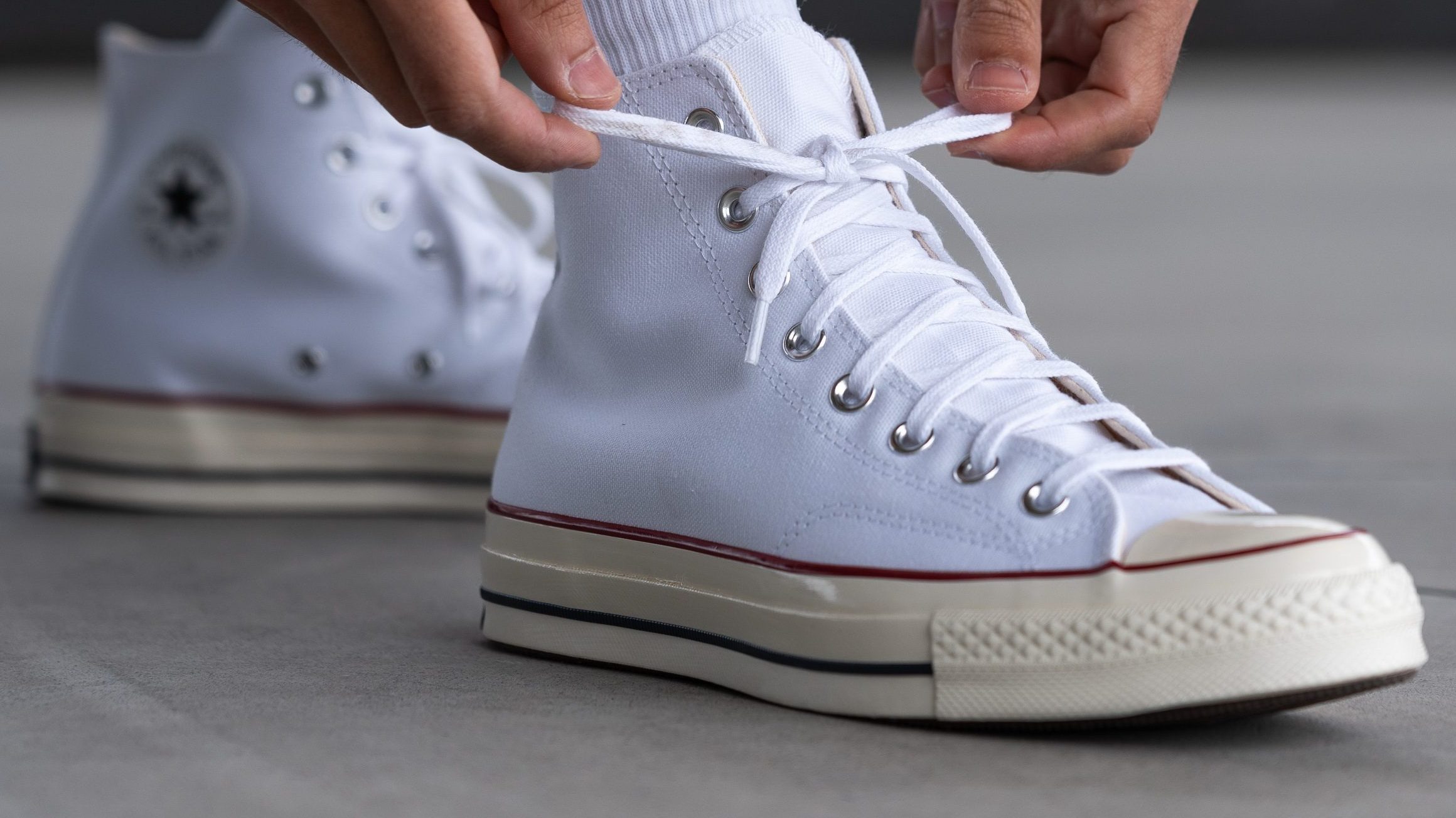
Can you just get Versalift inserts and use them with any shoe?
Versalifts help by adding a few millimeters to the heel-to-toe drop but they don’t replace all the other features of a lifting shoe, i.e. stable and incompressible platform and secure lockdown.
So you can’t just put a Versalift inside a cushy running shoe and feel planted as a tree. Make sure that you are using it with a firm and stable cross-trainer to begin with.
Can you do weightlifting barefoot or in socks only?
It’s a yes, if it’s for deadlifting and if your gym rules allow it.
It’s a no, if you don’t have the necessary ankle mobility and proper squat form to lift heavy.
